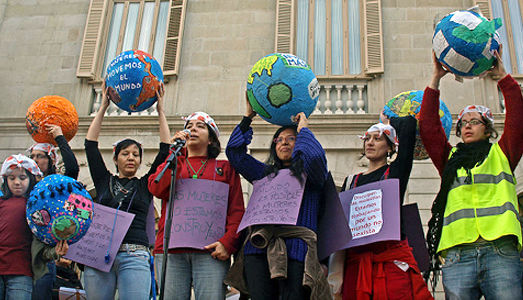
LONDON (Morning Star) – A hundred years have passed since the International Women’s Day was first conceived – which makes Monday especially important.
Over the last 10 to 15 years many thousands of women worldwide have begun to recognize and celebrate the day. But it is unfortunate that that its origins are not more widely known given its truly inspirational history.
Many claims have been made about the day’s origins, but most reputable sources agree that 1910 marks its establishment as an international day of sisterhood and solidarity for working women.
It is time to put the record straight if for no other reason that that the inheritors of the internationalist tradition laid in the 19th and 20th centuries – working-class, trade union and socialist women today – must reclaim our own history, study it, celebrate it and be inspired by it.
International Women’s Day grew from two sources – the struggle of working-class women to form trade unions and the fight for women’s right to vote. These issues united European women with their sisters in the United States.
In 1908 hundreds of women workers in the New York needle trades demonstrated in Rutgers Square in Manhattan’s Lower East Side to form their own union and demand the vote.
This historic demonstration took place on March 8. It led in the following year to an “uprising” of 30,000 women shirtwaist-makers which resulted in the first permanent trade unions for U.S. women workers.
News of the heroic fight by U.S. women workers reached Europe. In particular it inspired European socialist women who had established the International Socialist Women’s Conference on the initiative of German socialist feminist Clara Zetkin (1857-1933).
This met for the first time in 1907 in Stuttgart alongside one of the periodic conferences of the Second International (1889-1914). Three years later in 1910 Zetkin put forward a motion to the Copenhagen Conference of the Second International.
“The socialist women of all countries will hold each year a women’s day, whose foremost purpose it must be to aid the attainment of women’s suffrage. This demand must be handled in conjunction with the entire women’s question according to socialist precepts. The women’s day must have an international character and is to be prepared carefully.”
Zetkin’s motion was carried. March 8 was favored although no formal date was set. International Women’s Day was marked by rallies and demonstrations in the US and many European countries in the years leading to World War I, albeit on different days each year – for example March 18 in 1911 in Austria-Hungary, Germany, Denmark and Switzerland and the last Sunday in February in the US.
Zetkin, who was editor of Gleicheit (Equality), and Sylvia Pankhurst, editor of Women’s Dreadnought, saw that the struggle for women’s rights and women’s liberation was firmly tied into the struggle for socialism.
However, this did not mean that they were content to wait for the revolution before campaigning for working women. Both thought that socialism would be impossible to achieve without the active involvement of women.
“Just as the male worker is subjugated by the capitalist, so is the woman by the man, and she will always remain in subjugation until she is economically independent. Work is the indispensable condition for economic independence,” wrote Zetkin.
In 1917 in Russia International Women’s Day acquired greater significance – it became the flashpoint for the Russian Revolution.
On March 8 women workers in Petrograd held a massive strike and demonstration demanding Peace and Bread. The strike movement spread from factory to factory and effectively became an insurrection.
In 1922, in honor of the women’s role in 1917, Lenin declared that March 8 should be designated officially as women’s day.
Much later it became a national holiday in the Soviet Union and most of the former socialist countries. The cold war may explain why it was that a public holiday celebrated by communists was largely ignored in the West despite the fact that in 1975 – International Women’s Year – the United Nations recognized the day.
Today we acknowledge that International Women’s Day gives us an opportunity to draw attention to our own unfulfilled struggles for women’s rights, to link this with women’s struggles worldwide and to demonstrate international sisterly solidarity with working women everywhere.
Yet there is a danger that the socialist feminist origins of the day are being forgotten in the welter of “fun” events that have been organized in many cities worldwide.
We must not allow this to happen.
There is nothing wrong with women enjoying themselves, but we should also use the occasion to campaign for our current demands, supported by many trade unions, in the Charter for Women.
Professor Mary Davis chairs the TUC Women’s Conference which takes place in Eastbourne from Wednesday to Friday. Read the Morning Star for reports.
Read more about the Charter for Women at www.charterforwomen.org.uk
Photo: International Women’s Day in Barcelona, Spain 2009 Mutari/http://search.creativecommons.org/?q=International+Women%27s+Day&sourceid=Mozilla-search#

MOST POPULAR TODAY

High Court essentially bans demonstrations, freedom of assembly in Deep South

Zionist organizations leading campaign to stop ceasefire resolutions in D.C. area

U.S. imperialism’s ‘ironclad’ support for Israel increases fascist danger at home


UN warns that Israel is still blocking humanitarian aid to Gaza






Comments